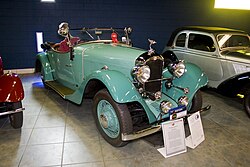- Fardier de Cugnot
- 1929 Ruxton
- 1956 Claveau
- 1967 Tatra 603
- 1973 Citroën SM
- 1929 Ford Model A Gazogene
- 1928 Tatra
- 1953 Hotchkiss Gregoire Coupe
- DKW Meisterklasse
- 1933 Derby V8
- Chenard-Walcker T9T
- Citroën 2CV Sahara
- 1965 Ford Mustang AWD
- Tatra T75
- Jensen 541 Prototype
- Hanomag Kommissbrot
- 1950 Talbot-Lago
 Tampa Bay Automobile Museum | |
| Established | March 19, 2005 |
|---|---|
| Location | Pinellas Park, Florida |
| Coordinates | 27°51′8.50″N82°40′44″W / 27.8523611°N 82.67889°W |
| Type | Automotive |
| Collections | Automotive engineering innovations, early 20th century art. |
| Collection size | 90 cars Automobilia, over 200 art and lithography displays |
| President | Oliver & Emmanuel Cerf |
| Curator | Susan Cerf |
| Website | tbauto.org |
The Tampa Bay Automobile Museum, located in Pinellas Park, Florida in the Tampa Bay Area, displays historic automobiles from the 20th century. Established by French entrepreneur Alain Cerf, the museum emphasizes vehicles that demonstrate exceptional creativity and innovation.
Contents
The museum's diverse collection reflects Cerf's passion for mechanical ingenuity and historical significance. Featuring vehicles from both well-known manufacturers and obscure visionaries, the exhibits tell the story of automotive evolution through groundbreaking engineering concepts.
What sets this museum apart is its focus on technological advancements that were ahead of their time, including front-wheel-drive pioneers from the early 20th century, air-cooled V8 rear-engine cars from Tatra, and early electric and hybrid vehicles that predate modern eco-friendly cars by a century. The collection also includes rare prototypes and one-of-a-kind models that demonstrate the experimental spirit of automotive pioneers.
Among the most remarkable exhibits is a fully operational, full-scale replica of the Fardier de Cugnot—the world’s first self-propelled mechanical vehicle, originally built in 1770 by French military engineer Nicolas-Joseph Cugnot. The replica faithfully reproduces the steam-powered design that marked the dawn of automotive history, showcasing the ingenuity that laid the foundation for modern transportation.
In addition to preserving automotive history, the museum actively engages in restoration projects to maintain the vehicles in pristine working condition. Each car is meticulously maintained and, when possible, restored to its original operational state.
In 2019, the museum held an event demonstrating hydrogen-fueled buses and discussing their use for local transit. [1]






















